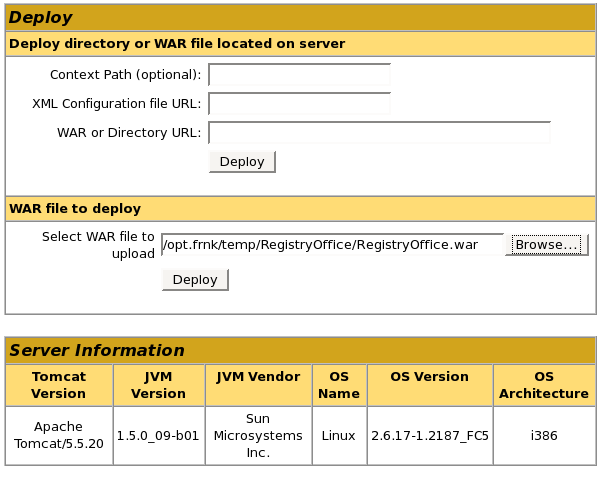Table of Contents
RegistryOffice is Java based application, which is usually deployed as a servlet inside the Tomcat or other compatible container. Data are stored in a relational database. For testing purposes or smaller installations embedded Derby database can be used. Application is optimized to use Postgresql as a back-end. It is possible to add support for other databases as well - appropriate database schema can be generated using Hibernate.
Table 2.1. Requirements
| Component | Description |
|---|---|
| Tomcat | recommended minimal version is 5.5.x |
| Database (Derby, PostgreSQL) | appropriate relational database, application can used any database compatible with hibernate 3.x |
Application is distributed as one zip-file. To install application zip-file have to be unpack to the temporary directory.
Table 2.2. Directories
| Directory | Description |
|---|---|
| doc | Documentation |
| source-war | Source RegistryOffice.war - without
context.xml |
| sql | SQL scripts, database schema |
| tomcat | Configuration files for Tomcat |
| utils | Utility files: derby, generator, zip |
Next step is to create database structure. At this point we expect that there is existing Tomcat installation. If you did not install Tomcat, please do it.
SQL scripts are stored in the directory sql.
There are two subdirectories for Derby and Postgresql database. Each
directory contains script schema.xml which defines
database structure. This script is database specific. There are two
common scripts admin.sql (creates first user is
database - administrator) and data.sql (example of
values for various code lists)
There are scripts create (for Linux/Unix) and
create.bat (for Win32) to create and initialize
database. It is possible to accommodate these scripts as needed.
Database script schema.sql will create database
structure and admin.sql will first user.
Database drivers have to be accessible from the Tomcat
installation. Please copy them to the directory
[tomcat]/common/lib. Required files:
derby.jar, derbytools.jar.
It is possible to user the latest Derby distribution or files from the
directory utils/derby.
New database can be created using command line tools or visual
tools as pgadmin3. After creating database please
add schema from postgresql/schema.sql and first
user as shown in the file admin.sql.
Database driver have to be accessible from the Tomcat
installation. Please copy file
postgresql-jdbc3.jar from the postgresql
installation to the directory
[tomcat]/common/lib.
There have to be defined data source in the Tomcat which will be
used by application. This can be done manualy or using administration
tool. Example of data source configuration is in the file
tomcat/server.xml.resource for manual
configuration.
Data source configuration should be placed insided tag
<GlobalNamingResources>
Note
If you want to use Derby in embedded mode it have to be started
before any database connection is created. Copy files from
tomcat/derbyLoader to the directory
[tomcat]/server/classes and add following line to
the [tomcat]/conf/server.xml
<Listener className="LightComp.Derby.CatalinaLoader"
cacheSize="10000"/>Example 2.1. Resource configuration for Derby
<Resource
auth="Container"
description="Registry office"
name="jdbc/RegistryOfficeDB"
type="javax.sql.DataSource"
driverClassName="org.apache.derby.jdbc.EmbeddedDriver"
maxIdle="2"
maxWait="20000"
url="jdbc:derby:C:/karel/registryofficerepository/db;create=true"
maxActive="10"/>Example 2.2. Resource configuration for PostgreSQL
<Resource
auth="Container"
description="Registry office"
name="jdbc/RegistryOfficeDB"
type="javax.sql.DataSource"
password="rx12qw"
driverClassName="org.postgresql.Driver"
maxIdle="2"
maxWait="20000"
username="registryoffice"
url="jdbc:postgresql://127.0.0.1:5432/ro"
maxActive="10"/>RegistryOffice requires to configure several items:
data source
attribute mapping
logging file
First two configurations are stored in the file context.xml.
Template of this file is in the directory
doc.
<Context path="/RegistryOffice" reloadable="true">
<ResourceLink
global="jdbc/RegistryOfficeDB"
name="jdbc/RegistryOfficeDB"
type="javax.sql.DataSource"/>
<Resource
auth="Container"
description="Golem"
name="jdbc/GolemDB"
type="javax.sql.DataSource"
password="golem"
driverClassName="org.postgresql.Driver"
maxIdle="2"
maxWait="20000"
username="golem"
url="jdbc:postgresql://10.2.0.3:5432/GolemSimulation"
maxActive="10"/>
<Parameter name="DocumentIdAttribute" value="CJ"/>
<Parameter name="BatchIdAttribute" value="Scan.BatchId"/>
<Parameter name="AgencyIdAttribute" value="Scan.Agency"/>
</Context>There are two data sources.
RegistryOffice data source is configured as link to the globaly
defined resource. Name of resource must be jdbc/RegistryOfficeDB.
Change value of attribute global to point to the global resource
defined in the [tomcat]/config/server.xml.
Golem data source is connection to database of Golem system. Name of resource must be jdbc/GolemDB. Change value of attributes url,username,password to point to Golem database. JDBC dirvers for Golem database must be on classpath.
Three attributes have to be defined for each document entering RegistryOffice:
Table 2.3. Attributes
| DocumentIdAttribute | Unique identificator of each document |
| BatchIdAttribute | Identificator of batch. This is used to group documents together. If you does not need this value it can be set to same value for all documents. |
| AgencyIdAttribute | Identificator of source agency. |
Mapping of these attributes depends on the master information system and used values. Documents without these attributes will be revoked.
Logging configuration is stored in file
logging.properties. Template of this file is in
directory doc.
handlers = 1registryoffice.org.apache.juli.FileHandler 1registryoffice.org.apache.juli.FileHandler.level = FINE 1registryoffice.org.apache.juli.FileHandler.directory = c:/registryoffice/logs 1registryoffice.org.apache.juli.FileHandler.prefix = damis com.lightcomp.registryoffice.handlers = 1registryoffice.org.apache.juli.FileHandler
Value of the 1registryoffice.org.apache.juli.FileHandler.directory property must be set to full logging directory path.
Registry office can receive requests to store new document or delete document from external system. These requests are accepted via http protocol. From security reasons it is feasible to restrict access to this functionality. Access can be restricted only to some computers by using access filter. Access filter reject requests not comming from listed ip adresses. To use access filter add following sections to web.xml file.
<filter>
<filter-name>Access filter</filter-name>
<filter-class>com.lightcomp.registryoffice.authentication.AccessFilter</filter-class>
<init-param>
<param-name>addresses</param-name>
<param-value>10.2.0.6/255.255.255.255,127.0.0.1/255.255.255.255</param-value>
</init-param>
</filter>
<filter-mapping>
<filter-name>Access filter</filter-name>
<url-pattern>/upload</url-pattern>
</filter-mapping>Parameter adresses can contain coma separated list of ip addresses of computers in fomat IP/MASK.
Last step before deploying new application is to create file
RegistryOffice.war. There are two scripts to
create this file:
generate-war - Linux, Unix
generate-war.bat - Windows
generate-war <context.xml> <logging.properties> <hibernate.cfg.xml>
Script expects path to the properly configured
context.xml,
logging.properties and
hibernate.cfg.xml. These files will be added to
the RegistryOffice.war.
hibernate.cfg.xml is database specific
file. Preconfigured files are in the distribution for Derby and
PostgreSql.
To deploy new application to the server log as a manager to the
Tomcat. Select RegistryOffice.war and choose
Deploy.

Running application can be access using url: http://127.0.0.1:8080/RegistryOffice